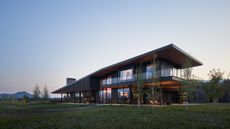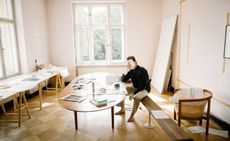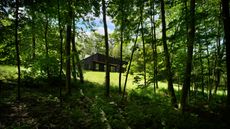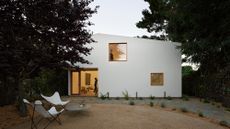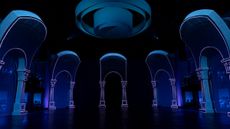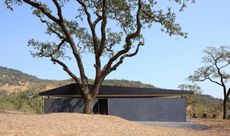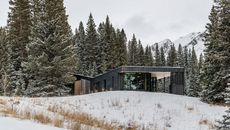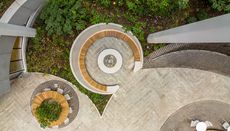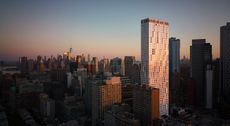Unbuilt Frank Lloyd Wright houses brought to life in 3D
Unbuilt Frank Lloyd Wright houses are celebrated in full, modern 3D glory, brought to life by home project specialist Angi
- (opens in new tab)
- (opens in new tab)
- (opens in new tab)
- Sign up to our newsletter Newsletter
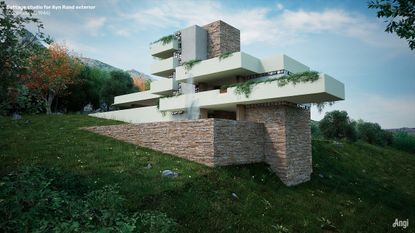
Intrigued by the fact that over half of Frank Lloyd Wright’s works were never built, home project internet company Angi took on an unusual task: to bring to life some of the midcentury American architecture master’s houses using the magic of contemporary 3D design. ‘Remarkably, more than half of Wright’s 1,171 architectural works never took a solid form. While unbuilt Frank Lloyd Wright houses occasionally materialise on the American landscape, 660 of his building designs remain confined to paper,’ says the company.
Three of these unrealised gems were selected to be digitally reconstructed, including Mrs David Devin House (Chicago, 1896), Cottage Studio for Ayn Rand (Connecticut, 1946), and Lake Tahoe Lodge (Lake Tahoe, California, 1923). To transform Wright’s expert and beautiful architectural drawings into photorealistic renders, Angi worked with creative studio NeoMam Studios. The London-based experts went through the architect’s archive sketches, plans and notes, while undertaking thorough research in order to compose a series of images that offer a tangible feel of what the buildings might have looked like, if realised.
‘The most inspiring part of this project was seeing Frank Llyod Wright's forgotten sketches come to life using modern technology. In particular, the plans of Mrs. David Devin House (Chicago, 1896) caught our team's eye because the plans were much more unusual than FLW's other plans and houses - that one became our favourite because it stands out as different to the typical style that FLW is known for,' says the team at NeoMam.
Unbuilt Frank Lloyd Wright houses rendered in 3D

The selected projects range in style and scope, displaying Wright’s extensive breadth of work. The Devlin House is an early concept, which employs unusual shapes and expressive ornamentation as the architect was exploring approaches, while other works, such as the Cottage Studio, bring to mind later work – especially the Kaufmann family’s famous Fallingwater. Yet they are all born of the architect’s highly crafted, detailed floorplans and sketches.
‘The most challenging part was designing the floor plans. The design team followed the plans and sketches as closely as possible, but some parts required additional research and an understanding of how existing FLW houses are built. With regards to the interiors, the research team took inspiration from famous FLW buildings, like Taliesin West and Hollyhock House,' the NeoMam team adds.
The trilogy’s third design, the home in Lake Tahoe, in particular, celebrates the value of unbuilt work. The architect has written on it: ‘The best [buildings] had life only on paper,’ wrote Wright in the early 1940s. ‘The most interesting and vital stories might belong to these children of imagination were they ever to encounter the field. Say, the Lake Tahoe project…’
The lodge design feels like a fantasy, utopian settlement, an ode to architecture and passion, a speculative project without a client, flagging up the power that these unrealised Frank Lloyd Wright houses have to fuel our imagination.




INFORMATION
angi.com (opens in new tab)
Ellie Stathaki is the Architecture Editor at Wallpaper*. She trained as an architect at the Aristotle University of Thessaloniki in Greece and studied architectural history at the Bartlett in London. Now an established journalist, she has been a member of the Wallpaper* team since 2006, visiting buildings across the globe and interviewing leading architects such as Tadao Ando and Rem Koolhaas. Ellie has also taken part in judging panels, moderated events, curated shows and contributed in books, such as The Contemporary House (Thames & Hudson, 2018) and Glenn Sestig Architecture Diary (2020).
-
 Sapir Bachar’s love for silver makes for abstract jewellery forms
Sapir Bachar’s love for silver makes for abstract jewellery formsSapir Bachar’s fashion background informs her eponymous jewellery brand
By Pei-Ru Keh • Published
-
 Spectacular Wyoming ranch sits within a restored working landscape
Spectacular Wyoming ranch sits within a restored working landscapeThis Wyoming ranch by CLB Architects offers a new approach to the Western architectural tradition, combining daring and functional modern design with a welcoming character
By Jonathan Bell • Published
-
 Last chance to see: Cyprien Gaillard on chaos, reorder and excavating a Paris in flux
Last chance to see: Cyprien Gaillard on chaos, reorder and excavating a Paris in fluxWe interviewed French artist Cyprien Gaillard ahead of his major two-part show, ‘Humpty \ Dumpty’ at Palais de Tokyo and Lafayette Anticipations (until 8 January 2023). Through abandoned clocks, love locks and asbestos, he dissects the human obsession with structural restoration
By Harriet Lloyd-Smith • Published
-
 Spectacular Wyoming ranch sits within a restored working landscape
Spectacular Wyoming ranch sits within a restored working landscapeThis Wyoming ranch by CLB Architects offers a new approach to the Western architectural tradition, combining daring and functional modern design with a welcoming character
By Jonathan Bell • Published
-
 Columbia County house combines prefabricated methods with meticulous planning
Columbia County house combines prefabricated methods with meticulous planningThe House of Courtyards, a new Columbia County house, is a refined living space in the heart of a secluded wooded plot
By Jonathan Bell • Published
-
 Cheng+Snyder transforms suburban Californian backlot into flexible home
Cheng+Snyder transforms suburban Californian backlot into flexible homeThe Roommate House by Cheng+Snyder in Oakland exemplifies fresh approaches to planning for ever-changing demographics
By Jonathan Bell • Published
-
 Stage architecture, from Disney to dance
Stage architecture, from Disney to danceClever stage architecture makes or breaks a cultural experience – from Yellow Studio’s set for Disney’s new live-action Beauty and the Beast, to more immersive structures in the genre
By Martha Elliott • Published
-
 This bijou Sonoma County house is in sync with the landscape
This bijou Sonoma County house is in sync with the landscapeAn open and contextual Sonoma County house, Leit House is designed by San Francisco’s Schwartz and Architecture
By Ellie Stathaki • Published
-
 This snowy Rockies retreat is the perfect Colorado family stay
This snowy Rockies retreat is the perfect Colorado family stayDNA Alpine by CCY Architects is a family Colorado Rockies retreat, designed to provide the perfect mountain sports and snowy getaway experience
By Ellie Stathaki • Last updated
-
 Lose yourself in 550 Madison and Snøhetta’s public garden
Lose yourself in 550 Madison and Snøhetta’s public gardenSnøhetta designs a new public garden for 550 Madison in New York
By Pei-Ru Keh • Published
-
 11 Hoyt by Studio Gang sets a new standard for Downtown Brooklyn
11 Hoyt by Studio Gang sets a new standard for Downtown Brooklyn11 Hoyt by Studio Gang has been completed, bringing a fresh residential offering to its Brooklyn neighbourhood
By Pei-Ru Keh • Last updated

